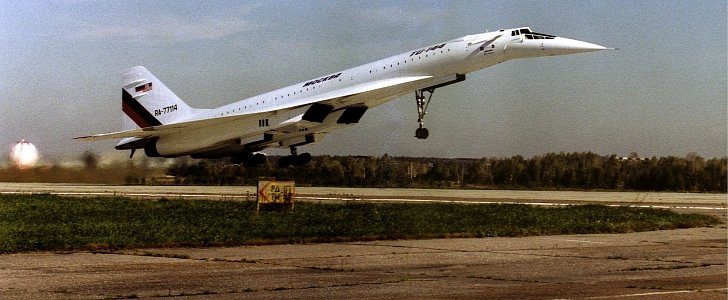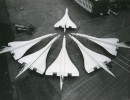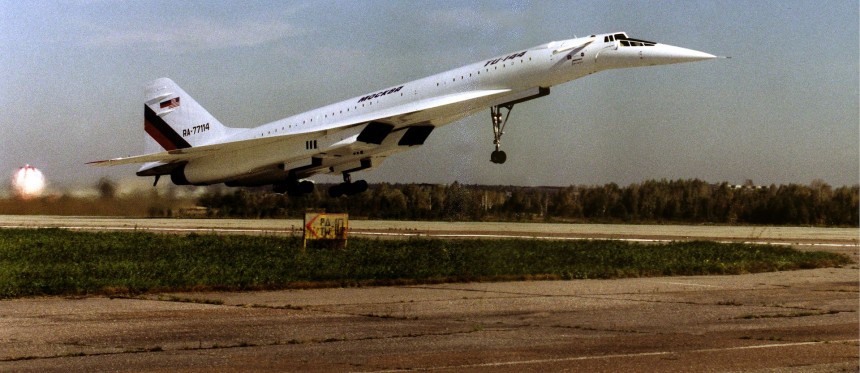The 1960s were a period of change, transition and unstoppable optimism. It was the age when propeller driven aircraft had all but been phased out by jets, man had successfully gone to space and returned and there was fervent technological competition between Western states and the Soviet Union.
One of the best examples of this competition has to be the case of supersonic passenger airliners, the Concorde and its Soviet equivalent, the Concordski, whose official name was Tupolev Tu-144.
The story apparently goes that Soviet officials caught wind of the Concorde project (a joint venture by France and the U.K.) in the mid-1960s and it immediately started their own similar program.
Even to this day, it’s not been officially confirmed that there was industrial espionage involved, but in spite of the fact that work on the Tu-144 started after the Concorde, its maiden flight took place a few months before. And not only that, but the Soviet supersonic passenger airliner was better in many ways than the Concorde, and its initial reception was actually very positive.
Concordski took to the sky for the first time on December 31, 1968, and it went supersonic for the first time on 5 June 1969. Concorde, on the other hand, had its maiden flight on 2 March 1969 and it went through the sound barrier for the first time on the first day of October that same year.
The Soviet Tu-144 was clearly very similar in its design to Concorde, but even though there were (and still are) suspicions that it is based on stolen intellectual property, there were a few notable differences between the two.
Firstly, it measured 67 m (215 ft) in length, or 3.7 m (12 ft) longer than Concorde. It was also more powerful, thanks to four strong engines that could deliver 44,000 pounds of thrust each, or around 6,000 pounds more thrust than the Concorde’s engines.
Granted, it needed the extra oomph to get itself in the air, as it weighed a smidgen under 100 tons, or some 20 tons more than Concorde. Some of this is attributed to the Soviet plane’s extensive undercarriage system.
It was still able to reach a maximum speed of 2,300 km/h (1,400 mph or Mach 2.15) and it had a cruising speed of 2,125 km/h (1,320 mph). Concorde could only reach a maximum of 2,180 km/h (1,354 mph or Mach 2.04).
It had a set of double wheels under the nose, as well as an additional twelve under the wings; some were redundant, an extra safety feature in case others failed, but the large number of wheels also has something to do with the fact that the Soviets used synthetic rubber which was more prone to failing.
Concordski had a passenger capacity of 140, 20 more than Concorde, but even after it entered service in 1977 and started carrying people, bookings were usually limited to about half that. It only carried 3,194 passengers over its 55 flights, an average of 58 passengers per flight.
The Soviets were apparently not particularly keen to have the plane in the air, because it was plagued by constant systems failures, so they limited the number of flights to as few as possible while still maintaining the plane provided regular service.
To give you an idea how bad it was, during the Tu-144’s 102 total flights (these also include cargo flights) that totaled 181 hours in the air, a total of 226 failures were recorded, of which 80 were in flight. This plus the fact that the plane got off on the wrong foot, breaking up in mid-air during the 1973 Paris air show, killing its entire crew of six and an additional eight people on the ground, as well as destroying 15 houses.
Life aboard Concordski wasn’t great - passengers had to shout to make themselves heard when talking to the person in the next seat. This was the case with Concorde too, although only during takeoff, when the afterburners were enabled (the noise was recorded at nearly 120 decibels) - for Concordski, the noise didn’t go away for the entirety of the flight.
But whereas Concordski didn’t get that much air time and ferried an insignificant number of passengers on only one route (Moscow to Almaty) before it was retired in 1978, Concorde fared much better in this respect. It flew over 90,000 hours for Air France and a number of others for British Airways, carrying a total of 1.4-million passengers.
And even if it wasn’t perfect (it was not as refined or quiet as non-supersonic airliners and it was nowhere near as efficient), Air France reportedly made a profit from operating it; the company made tickets on the plane quite expensive and it made financial sense to keep running it - it remained in active service until 2003, when all 20 aircraft were retired and they now reside in museums.
It must be mentioned that even though it proved to be the better design, the Concorde didn’t change the world, and it didn’t bring about a shift towards supersonic air travel for the masses. And even though it was technically superior to the Tu-144, one Concorde actually crashed during active service, in July 2000, killing all 109 people it was carrying on board - this tragedy is believed to have sparked the desire to have all planes grounded, and that happened just three years later.
This year marks the 50th anniversary of the Concorde’s first flight and the 16th anniversary of its final flight. You can see both Concorde (and Concordski) only in museums now, but most are still well maintained and some are still airworthy to this day.
The story apparently goes that Soviet officials caught wind of the Concorde project (a joint venture by France and the U.K.) in the mid-1960s and it immediately started their own similar program.
Even to this day, it’s not been officially confirmed that there was industrial espionage involved, but in spite of the fact that work on the Tu-144 started after the Concorde, its maiden flight took place a few months before. And not only that, but the Soviet supersonic passenger airliner was better in many ways than the Concorde, and its initial reception was actually very positive.
The Soviet Tu-144 was clearly very similar in its design to Concorde, but even though there were (and still are) suspicions that it is based on stolen intellectual property, there were a few notable differences between the two.
Firstly, it measured 67 m (215 ft) in length, or 3.7 m (12 ft) longer than Concorde. It was also more powerful, thanks to four strong engines that could deliver 44,000 pounds of thrust each, or around 6,000 pounds more thrust than the Concorde’s engines.
It was still able to reach a maximum speed of 2,300 km/h (1,400 mph or Mach 2.15) and it had a cruising speed of 2,125 km/h (1,320 mph). Concorde could only reach a maximum of 2,180 km/h (1,354 mph or Mach 2.04).
It had a set of double wheels under the nose, as well as an additional twelve under the wings; some were redundant, an extra safety feature in case others failed, but the large number of wheels also has something to do with the fact that the Soviets used synthetic rubber which was more prone to failing.
Concordski had a passenger capacity of 140, 20 more than Concorde, but even after it entered service in 1977 and started carrying people, bookings were usually limited to about half that. It only carried 3,194 passengers over its 55 flights, an average of 58 passengers per flight.
The Soviets were apparently not particularly keen to have the plane in the air, because it was plagued by constant systems failures, so they limited the number of flights to as few as possible while still maintaining the plane provided regular service.
To give you an idea how bad it was, during the Tu-144’s 102 total flights (these also include cargo flights) that totaled 181 hours in the air, a total of 226 failures were recorded, of which 80 were in flight. This plus the fact that the plane got off on the wrong foot, breaking up in mid-air during the 1973 Paris air show, killing its entire crew of six and an additional eight people on the ground, as well as destroying 15 houses.
Life aboard Concordski wasn’t great - passengers had to shout to make themselves heard when talking to the person in the next seat. This was the case with Concorde too, although only during takeoff, when the afterburners were enabled (the noise was recorded at nearly 120 decibels) - for Concordski, the noise didn’t go away for the entirety of the flight.
But whereas Concordski didn’t get that much air time and ferried an insignificant number of passengers on only one route (Moscow to Almaty) before it was retired in 1978, Concorde fared much better in this respect. It flew over 90,000 hours for Air France and a number of others for British Airways, carrying a total of 1.4-million passengers.
And even if it wasn’t perfect (it was not as refined or quiet as non-supersonic airliners and it was nowhere near as efficient), Air France reportedly made a profit from operating it; the company made tickets on the plane quite expensive and it made financial sense to keep running it - it remained in active service until 2003, when all 20 aircraft were retired and they now reside in museums.
It must be mentioned that even though it proved to be the better design, the Concorde didn’t change the world, and it didn’t bring about a shift towards supersonic air travel for the masses. And even though it was technically superior to the Tu-144, one Concorde actually crashed during active service, in July 2000, killing all 109 people it was carrying on board - this tragedy is believed to have sparked the desire to have all planes grounded, and that happened just three years later.
This year marks the 50th anniversary of the Concorde’s first flight and the 16th anniversary of its final flight. You can see both Concorde (and Concordski) only in museums now, but most are still well maintained and some are still airworthy to this day.









